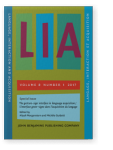Adami, Elisabetta & Ruth Swanwick
2024.
Signs of understanding and turns-as-actions: a multimodal analysis of deaf–hearing interaction.
Visual Communication 23:1
► pp. 4 ff.

Baggio, Guido
2023.
Gesture, meaning, and intentionality: from radical to pragmatist enactive theory of language.
Phenomenology and the Cognitive Sciences 
Rinaldi, Pasquale, Patrizio Pasqualetti, Virginia Volterra & Maria Cristina Caselli
2023.
Gender differences in early stages of language development. Some evidence and possible explanations.
Journal of Neuroscience Research 101:5
► pp. 643 ff.

Wille, Beatrijs, Hilde Nyffels & Olga Capirci
Capirci, Olga, Morgana Proietti & Virginia Volterra
Rinaldi, Pasquale, Arianna Bello, Francesca Romana Lasorsa & Maria Cristina Caselli
2022.
Do Spoken Vocabulary and Gestural Production Distinguish Children with Transient Language Delay from Children Who Will Show Developmental Language Disorder? A Pilot Study.
International Journal of Environmental Research and Public Health 19:7
► pp. 3822 ff.

Rodríguez, Fernando G. & Silvia Español
2022.
The Transition from Early Bimodal Gesture-Word Combinations to Grammatical Speech. In
Moving and Interacting in Infancy and Early Childhood,
► pp. 207 ff.

Sparaci, Laura, Domenico Formica, Francesca Romana Lasorsa, Luigi Raiano, Paola Venuti & Olga Capirci
2022.
New Methods for Unraveling Imitation Accuracy Differences Between Children with Autism and Typically Developing Peers.
Perceptual and Motor Skills 129:6
► pp. 1749 ff.

Stewart, Jessica R., Ruth Crutchfield & Wan-Lin Chang
2022.
Prelinguistic gesture and developmental abilities: A multi-ethnic comparative study.
Infant Behavior and Development 68
► pp. 101748 ff.

Lasorsa, Francesca Romana, Maria Cristina Caselli, Ilaria Simonelli, Silvia Stefanini, Patrizio Pasqualetti & Pasquale Rinaldi
2021.
Exploring Agreement between MB-CDI Short Forms for Evaluating the Language Skills of Italian Children Aged 18–24 Months.
Folia Phoniatrica et Logopaedica 73:6
► pp. 552 ff.

Bello, Arianna, Silvia Stefanini, Pasquale Rinaldi, Daniela Onofrio & Virginia Volterra
Capobianco, Micaela & Luca Cerniglia
2020.
Coarticolazione temporale nelle combinazioni di gesti e parole: dati longitudinali in bambini nati a termine e pretermine nei primi due anni di età.
RICERCHE DI PSICOLOGIA :2
► pp. 547 ff.

Lüke, Carina, Ute Ritterfeld, Angela Grimminger, Katharina J. Rohlfing & Ulf Liszkowski
2020.
Integrated Communication System: Gesture and Language Acquisition in Typically Developing Children and Children With LD and DLD.
Frontiers in Psychology 11

Tomasuolo, Elena, Chiara Bonsignori, Pasquale Rinaldi & Virginia Volterra
2020.
The representation of action in Italian Sign Language (LIS).
Cognitive Linguistics 31:1
► pp. 1 ff.

Batista, Aurore, Marie-Thérèse Le Normand & Jean-Marc Colletta
2019.
Chapitre 3. Rôle et évolution des combinaisons bimodales au cours de l’acquisition du langage. Données chez l’enfant francophone âgé de 18 à 42 mois. In
Multimodalité du langage dans les interactions et l’acquisition,

Cattani, Allegra, Caroline Floccia, Evan Kidd, Paola Pettenati, Daniela Onofrio & Virginia Volterra
2019.
Gestures and Words in Naming: Evidence From Crosslinguistic and Crosscultural Comparison.
Language Learning 69:3
► pp. 709 ff.

Humphries, Tom, Poorna Kushalnagar, Gaurav Mathur, Donna Jo Napoli, Christian Rathmann & Scott Smith
2019.
Support for parents of deaf children: Common questions and informed, evidence-based answers.
International Journal of Pediatric Otorhinolaryngology 118
► pp. 134 ff.

Salo, Virginia C., Pier F. Ferrari & Nathan A. Fox
2019.
The role of the motor system in action understanding and communication: Evidence from human infants and non‐human primates.
Developmental Psychobiology 61:3
► pp. 390 ff.

Sansavini, Alessandra, Annalisa Guarini, Mariagrazia Zuccarini, Jessica Zong Lee, Giacomo Faldella & Jana Marie Iverson
2019.
Low Rates of Pointing in 18-Month-Olds at Risk for Autism Spectrum Disorder and Extremely Preterm Infants: A Common Index of Language Delay?.
Frontiers in Psychology 10

Fibigerova, Katerina, Jean-Marc Colletta & Michèle Guidetti
Fibigerova, Katerina, Jean-Marc Colletta & Michèle Guidetti
Volterra, Virginia, Olga Capirci, Pasquale Rinaldi & Laura Sparaci
Volterra, Virginia, Olga Capirci, Pasquale Rinaldi & Laura Sparaci
Zuccarini, Mariagrazia, Annalisa Guarini, Jana Marie Iverson, Erika Benassi, Silvia Savini, Rosina Alessandroni, Giacomo Faldella & Alessandra Sansavini
2018.
Does early object exploration support gesture and language development in extremely preterm infants and full-term infants?.
Journal of Communication Disorders 76
► pp. 91 ff.

Sparaci, Laura & Virginia Volterra
2017.
Hands Shaping Communication: From Gestures to Signs. In
The Hand [
Studies in Applied Philosophy, Epistemology and Rational Ethics, 38],
► pp. 29 ff.

This list is based on CrossRef data as of 22 october 2024. Please note that it may not be complete. Sources presented here have been supplied by the respective publishers.
Any errors therein should be reported to them.
